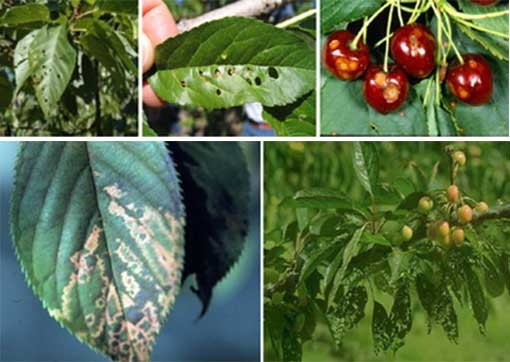As mentioned last issue, some hints on how to improve the crop disease situation are presented here.
Shothole
Shothole or corynelium blight is a fungal disease that creates holes in leaves and can produce rough areas on the fruit.
It is caused by the pathogen Wilsonomyces carpophilus. It can overwinter in infected buds and twigs.
Spores are spread in spring when it rains or with overhead irrigation.
Infection can begin when the temperature reaches 25C for a period of six hours.
Control
Spores can remain viable for months and are often airborne.
With the prolonged prevailing winds taking place this season it is just as well that cherry growing regions have been drier than average.
As fungi thrive in wet moist conditions, avoid overhead irrigation. To help prevent the spread remove infected leaves fruit and twigs. In autumn, copper sprays may assist control.
Bacterial gummosis (Pseudomonas syringae)
For the past five decades or so, the main control promoted for bacterial gummosis in Australia has been the regular use of copper sprays.
There is scientific evidence that copper sprays in parts of the USA and other countries are not controlling the disease or having a significant effect in reducing the damage caused by bacterial gummosis.
I am aware that in Australia there are cherry orchards that have regularly applied five copper sprays per year and still a serious problem remains with damage from bacterial gummosis.
A project went before Cherry Growers Australia a few years back to check the efficacy of copper sprays and the possible resistance of bacterial gummosis but it failed to get funding.
With that in mind, here is a link to findings from scientists at Oregon State University and their suggested control measures:
catalog.extension.oregonstate.edu/em9007
Below are the steps they recommend to manage bacterial canker:
•Do not interplant new trees with old trees, which are major sources of P. syringae.
•Keep irrigation water off above-ground tree parts as much as possible for the first two or three years after planting.
•Avoid all types of injury, including mechanical, insect, and frost injuries. Paint all trunks white with latex paint to prevent winter injury.
•Less disease occurs when summer pruning is used. Prune only during dry weather.
•Remove and destroy branches and trees killed by P. syringae.
•For recommendations on resistant cultivar/rootstock combinations, see discussion in text.
•Locate the orchard in an area less likely to be affected by frost and slow drying conditions.
•Provide optimal soil conditions for growth of sweet cherries, including attention to pH and nutrition. Application of excess nitrogen, especially late in the growing season, may promote late-season growth that is susceptible to low-temperature injury in early winter, followed by bacterial infection.
•Control weeds, especially grasses. They often support large populations of P. syringae. Clover and vetch groundcovers support lower populations. Consider clean cultivation of row middles for the first three years.
Strains of P. syringae resistant to copper-based bactericides are widespread in the Mid-Columbia area. Copper sprays may result in more bacterial canker and should not be used.
•Test for and control plant pathogenic nematodes before planting. High populations of ring nematode have been associated with more bacterial canker.
•In high infection areas, plant trees later in spring to avoid cool, wet conditions.
Prunus necrotic ringspot virus (PNRSV)
This is a plant pathogenic virus causing ring spot diseases affecting species of the genus Prunus, as well as other species such as rose and hops.
PNRSV is found worldwide due to easy transmission through plant propagation methods and infected seed.
It can be spread through nursery stock and root grafting.
It is important to use virus tested cherry material whenever available.
However, once cherry trees reach the age when they blossom, the virus can spread from other infected trees by transmission of pollen by bees and other pollinators.
See this article in Tree Fruit Dec 2019




















